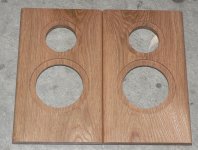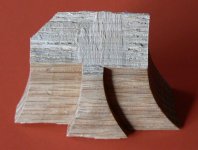Hi all,
New here, but been reading some of the advice on here for a long while.
I'm a total hobbyist builder, got a few self designed sets around the house and a few friends have asked for them.
It's my dad's birthday next month and I though a nice set of custom speakers for his wee Denon mini system would be nice. Nothing majorly fancy but he does have a livingroom full of white oak furniture.
With that in mind, (and I have read a lot, and I mean a lot, of conflicting views on using solid wood), I though about using 18mm (~3/4") solid oak for the sides, top and bottom, mitred at the corners to try and create a "flow" from panel to panel and look to offset/minimise movement.
For the backs I plan on using oak, cut as an "insert" slightly recessed and screwed to some rails inside sealed with 3M VHB foam tape (I think the black Torx screws would look great). I would use the insulating tape so that I can leave a small gap for movement and still have a sealed enclosure.
For the front, plain old 18mm MDF again as a slightly recessed insert glued in place with the single Dayton Audio RS100-8 and a front firing port cut out and then primed and painted gloss black (to contrast the oak).
Internally, a single 18mm MDF brace under the woofer inside a cabinet that would be 300mm (~12") tall, 150mm (~6") wide and 200mm (~8") deep.
Now, in my head this seems reasonable sensible, they would look good with the "constantly flowing" oak grain as they will be cut from one board and finished with a lovely clear matt Black Bison Wax.
I totally get that I could use an oak veneer but I have had mixed results with veneers and there's something about the weight of solid wood.
Thanks for any or all input all
Wherever you are, have a great day and thanks for reading.
New here, but been reading some of the advice on here for a long while.
I'm a total hobbyist builder, got a few self designed sets around the house and a few friends have asked for them.
It's my dad's birthday next month and I though a nice set of custom speakers for his wee Denon mini system would be nice. Nothing majorly fancy but he does have a livingroom full of white oak furniture.
With that in mind, (and I have read a lot, and I mean a lot, of conflicting views on using solid wood), I though about using 18mm (~3/4") solid oak for the sides, top and bottom, mitred at the corners to try and create a "flow" from panel to panel and look to offset/minimise movement.
For the backs I plan on using oak, cut as an "insert" slightly recessed and screwed to some rails inside sealed with 3M VHB foam tape (I think the black Torx screws would look great). I would use the insulating tape so that I can leave a small gap for movement and still have a sealed enclosure.
For the front, plain old 18mm MDF again as a slightly recessed insert glued in place with the single Dayton Audio RS100-8 and a front firing port cut out and then primed and painted gloss black (to contrast the oak).
Internally, a single 18mm MDF brace under the woofer inside a cabinet that would be 300mm (~12") tall, 150mm (~6") wide and 200mm (~8") deep.
Now, in my head this seems reasonable sensible, they would look good with the "constantly flowing" oak grain as they will be cut from one board and finished with a lovely clear matt Black Bison Wax.
I totally get that I could use an oak veneer but I have had mixed results with veneers and there's something about the weight of solid wood.
Thanks for any or all input all
Wherever you are, have a great day and thanks for reading.
Planks or narrow stave board which should be more stable?
What joints are you planning?
What will you do when the wood warps and joints open up(cry?)?
Why not oak veneered plywood?
I am sure others will chime in that solid wood will be more resonant and ply better at damping panel resonances.
What joints are you planning?
What will you do when the wood warps and joints open up(cry?)?
Why not oak veneered plywood?
I am sure others will chime in that solid wood will be more resonant and ply better at damping panel resonances.
Everything you proposed is fine. Except don't use solid oak boards. Use oak plywood. Solid boards will warp and crack over time and the joints will open. Plywood, in contrast, is mechanically stable over time. If you want you can use plywood and join battens to the ends so you never see the plywood edges. This is a waste of time IMHO, but some prefer the look.
Planks or narrow stave board which should be more stable?
What joints are you planning?
What will you do when the wood warps and joints open up(cry?)?
Why not oak veneered plywood?
I am sure others will chime in that solid wood will be more resonant and ply better at damping panel resonances.
Planks are 120mm wide (biscuit jointed in to a 2400 x 240 wide plank).
Joints I was planning mitred corners so that there would be no end-grain visible.
Oak plywood is not in plentiful supply where I live and it's prohibitively expensive (c. £60 for a 1220 x 2440 sheet).
Everything you proposed is fine. Except don't use solid oak boards. Use oak plywood. Solid boards will warp and crack over time and the joints will open. Plywood, in contrast, is mechanically stable over time. If you want you can use plywood and join battens to the ends so you never see the plywood edges. This is a waste of time IMHO, but some prefer the look.
As above, Oak ply is ridiculously expensive where I am.
Also, I hate exposed plywood ends/edges. It just looks cheap and nasty to me. Even mitring the corners would leave me with an exposed set of edges front and back.
Look into what glue works the best for the wood if you have not.
If you know how to avoid glue joints cracking over time, that will help.
The next part is see if you need bracing. The one problem with hardwoods like Oak is the resonances can be worse or higher in pitch compared to softwoods. You may need cross bracing to avoid this problem. Also the glue joints need to not crack over time.
Lots of luck. I am just waiting for my local tree guy to bring me a pile of maple.
If you know how to avoid glue joints cracking over time, that will help.
The next part is see if you need bracing. The one problem with hardwoods like Oak is the resonances can be worse or higher in pitch compared to softwoods. You may need cross bracing to avoid this problem. Also the glue joints need to not crack over time.
Lots of luck. I am just waiting for my local tree guy to bring me a pile of maple.
Working with solid is an art… but a true work of art can be done if you know what you are doing.
Yew. Oak. Walnut. Douglas Fir.
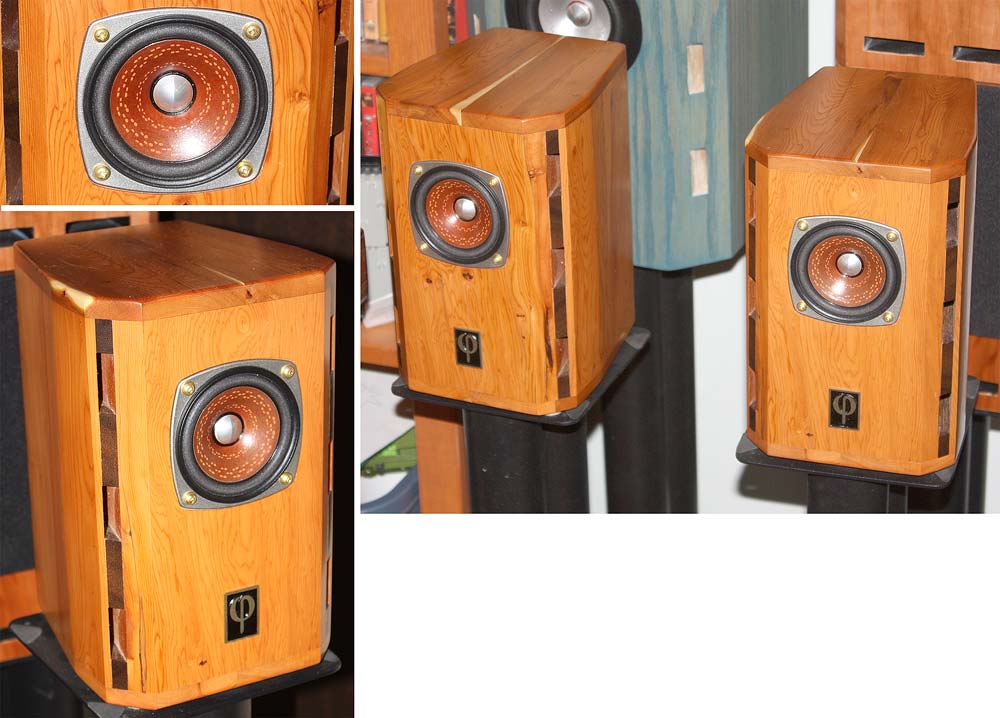
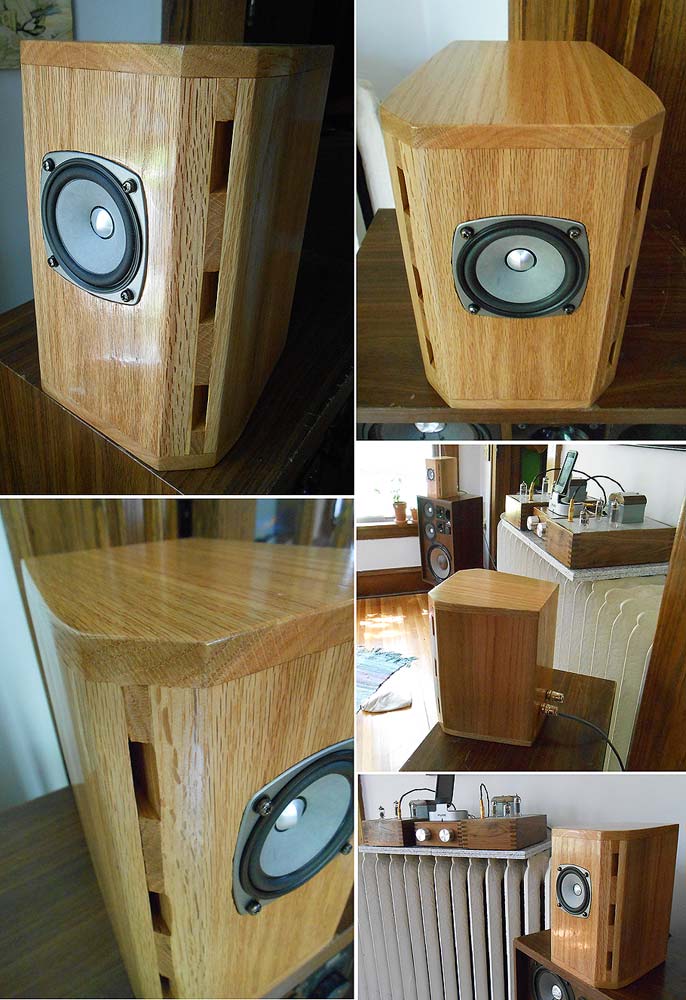
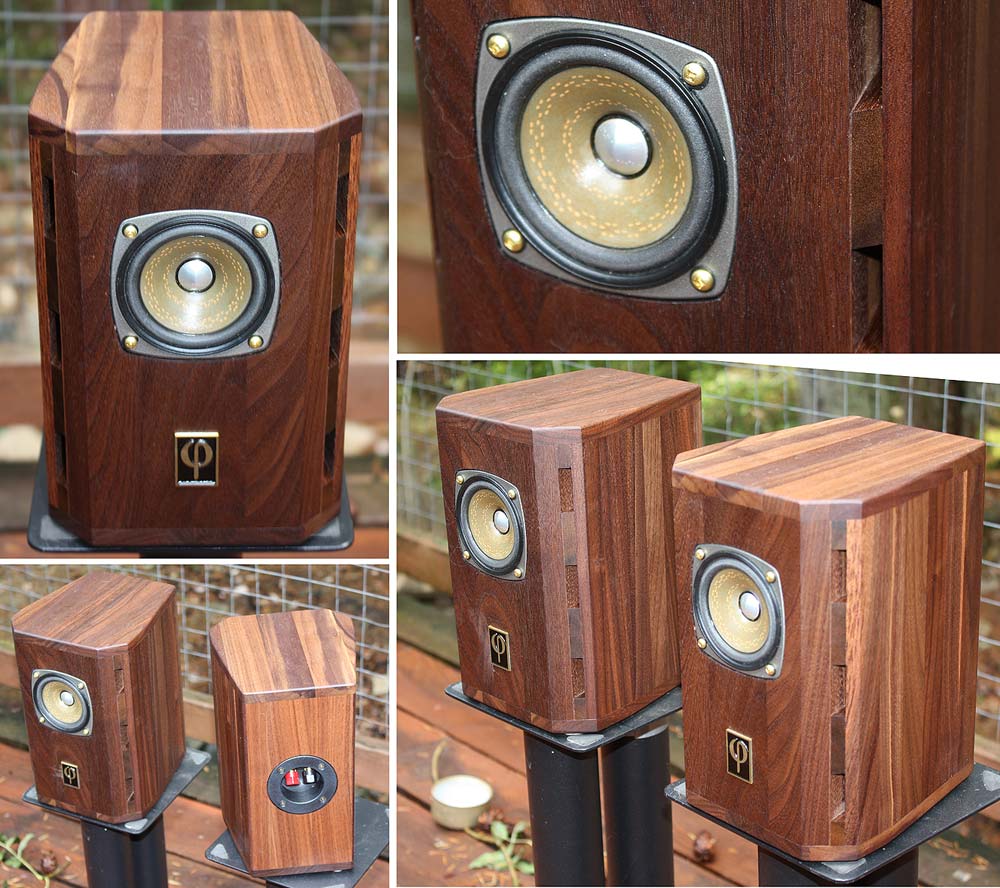
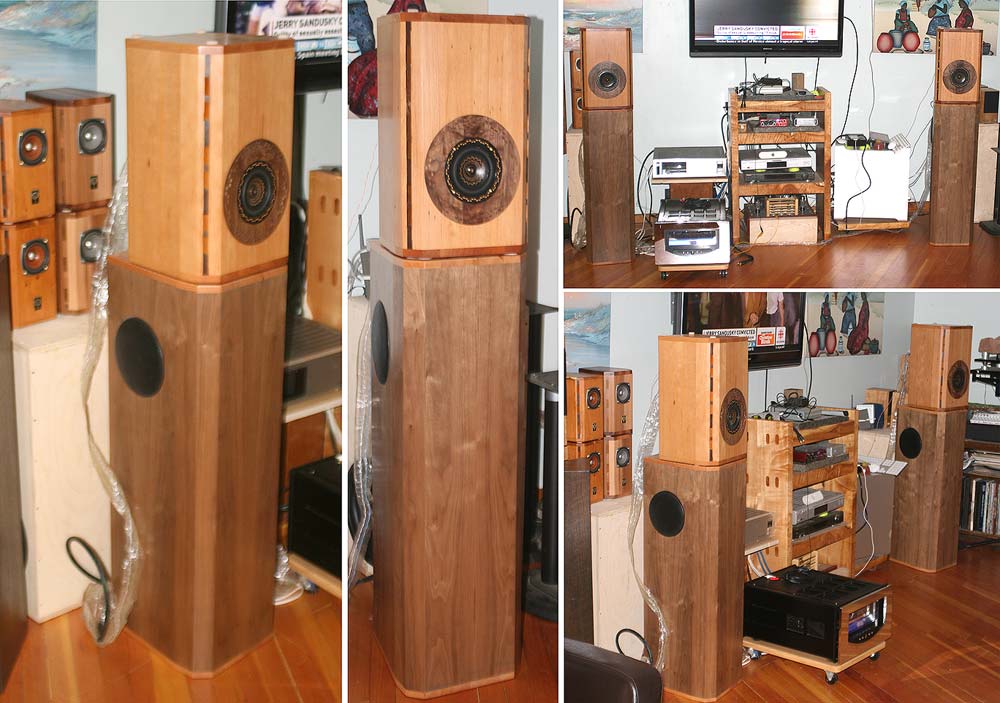
Solid wood is more likely to fail than if you use quality plywood.
IMO, MDF is not suitable for building loudspeakers, except when it is all you can get.
It makes particularily poor braces and anything on the outside of the box that is not oak will destroy any artistic integrity.
All of the above are solid solid, larger panels all made from narrower bits.
I have more examples if you’d like. All of these were built by Bernie. I also have some yellow cedar boxes Scott D did.
dave
Yew. Oak. Walnut. Douglas Fir.




Solid wood is more likely to fail than if you use quality plywood.
IMO, MDF is not suitable for building loudspeakers, except when it is all you can get.
It makes particularily poor braces and anything on the outside of the box that is not oak will destroy any artistic integrity.
All of the above are solid solid, larger panels all made from narrower bits.
I have more examples if you’d like. All of these were built by Bernie. I also have some yellow cedar boxes Scott D did.
dave
Alas any material that makes good musical instruments will tend to have strong resonances and isn't the go-to material for a speaker enclosure - tapping a speaker should sound dull and lifeless, not like a hitting a zylophone. (Zylo-phone = "wood" "sound"!)
This means hardwood enclosures need careful attention to thickness, bracing and interior damping materials or mass-loading to get a well-behaved spectral response. MDF has a head start being fairly well damped by its nature, and is cheap to use in thick panels, so for commercial production its a no-brainer to use veneer covered MDF for a cost-effective design. I agree nothing beats the appearance of a fine wood, and its a recyclable material (MDF is not good at this).
I suppose you can try to marry an outer layer of hardwood onto an interior box of (perhaps MDF), say with a visco-elastic glue, giving something whose acoustic properties are less affected by any warping, and benefitting from the damping layer - like a thick 2-ply.
Wood cricket bats use (or used) rubber layers in the bat and handle to damp vibration from the impact - seems to be effective there
This means hardwood enclosures need careful attention to thickness, bracing and interior damping materials or mass-loading to get a well-behaved spectral response. MDF has a head start being fairly well damped by its nature, and is cheap to use in thick panels, so for commercial production its a no-brainer to use veneer covered MDF for a cost-effective design. I agree nothing beats the appearance of a fine wood, and its a recyclable material (MDF is not good at this).
I suppose you can try to marry an outer layer of hardwood onto an interior box of (perhaps MDF), say with a visco-elastic glue, giving something whose acoustic properties are less affected by any warping, and benefitting from the damping layer - like a thick 2-ply.
Wood cricket bats use (or used) rubber layers in the bat and handle to damp vibration from the impact - seems to be effective there
Even veneered MDF is high cost here. I'd be looking at £55 for an 18mm sheet plus £35 to have it delivered.
I already have the oak (and I have MDF kicking about too). I'm tempted to just give it a go and use lots of internal dampening. The other options (ply/mdf) whilst they are better options, they are overly expensive and I think the finish will look naff.
I usually use MDF and paint it for the ones I have built to date, save a couple I veneered with mixed results.
I already have the oak (and I have MDF kicking about too). I'm tempted to just give it a go and use lots of internal dampening. The other options (ply/mdf) whilst they are better options, they are overly expensive and I think the finish will look naff.
I usually use MDF and paint it for the ones I have built to date, save a couple I veneered with mixed results.
The solid oak for sides, top and bottom, will be fine as long as you have (and I get that impression from your description) the grain is running 'around' the box. There will be movement of the wood but it will be front to back and uniform for those four pieces. You need to ensure you don't have any internal braces which would restrict that movement. Your front panel will be fine in MDF (or Baltic birch plywood if you listen to Dave) but your back panel is a concern. The front panel won't move, but your back, as proposed, will. If you insist on the appearance of oak on the back, I'd suggest oak veneer - if available where you are - over MDF or Baltic birch ply.
Sure a mitre joint is, well a joint? Even its wiki definition describes it as so.
That aside, I could use batons inside and wrap the mitres around them. I want to be able to round over the edges front to back and use dark stain.
What do you suggest if not steel screws? I think all of my screws (and possibly nails) are steel. I was going to attach the inner batons with 18g brad nails.
On the back panel, one of the previojsnposters suggested it was not a good idea due to movement but this is why I was proposing leaving an expansion gap around the outside and seal it to inner batons using foam tape.
I built a cabinet out of mdf yesterday and rounded over the edges, looks naff and only really leaves the option of paint finish which is not the look I am going for (apart from I hate painting MDF as its unpredictable what overall finish you will get).
That aside, I could use batons inside and wrap the mitres around them. I want to be able to round over the edges front to back and use dark stain.
What do you suggest if not steel screws? I think all of my screws (and possibly nails) are steel. I was going to attach the inner batons with 18g brad nails.
On the back panel, one of the previojsnposters suggested it was not a good idea due to movement but this is why I was proposing leaving an expansion gap around the outside and seal it to inner batons using foam tape.
I built a cabinet out of mdf yesterday and rounded over the edges, looks naff and only really leaves the option of paint finish which is not the look I am going for (apart from I hate painting MDF as its unpredictable what overall finish you will get).
The solid oak for sides, top and bottom, will be fine as long as you have (and I get that impression from your description) the grain is running 'around' the box. There will be movement of the wood but it will be front to back and uniform for those four pieces. You need to ensure you don't have any internal braces which would restrict that movement. Your front panel will be fine in MDF (or Baltic birch plywood if you listen to Dave) but your back panel is a concern. The front panel won't move, but your back, as proposed, will. If you insist on the appearance of oak on the back, I'd suggest oak veneer - if available where you are - over MDF or Baltic birch ply.
If I leave an expansion gap around the back panel and screw it to inner batons lined with 3M VHB foam tape, would that not work, like when I build drawers, I leave expansion gaps on the hardwood drawer liners.
Batons in the corners, which typically would have the grain oriented lengthwise, would work against the movement of the sides/top/bottom. Don't do it. There are specific ways to circumvent that issue in furniture, such as chests of drawers, but that wouldn't work in this case.
Mitres are a joint, just not a strong one without reinforcement. If you have a biscuit joiner, use it. Alternatively, with the right jig, you could dowel.
You might consider butting the sides against the top/bottom which would make doweling, or biscuits, easier. Aesthetically, you might allow a moderate overhang of the top/bottom - in the order of .125"/3 mm (that overhang also eliminates the need to be deadly accurate on a flush joint).
Mitres are a joint, just not a strong one without reinforcement. If you have a biscuit joiner, use it. Alternatively, with the right jig, you could dowel.
You might consider butting the sides against the top/bottom which would make doweling, or biscuits, easier. Aesthetically, you might allow a moderate overhang of the top/bottom - in the order of .125"/3 mm (that overhang also eliminates the need to be deadly accurate on a flush joint).
Go for the oak. At 18mm thick in a bookshelf sized speaker the resonant frequency will be far to high to hear and I suspect your Dad is unlikely to play loud enough to generate resonances anyway.
The main thing with any solid wood is to make sure its fully and properly dry, stacked and cured before fabrication - but I am sure if you are a wood freak like me you would have heaps waiting patiently in the rafters of your shed.
The main thing with any solid wood is to make sure its fully and properly dry, stacked and cured before fabrication - but I am sure if you are a wood freak like me you would have heaps waiting patiently in the rafters of your shed.
Batons in the corners, which typically would have the grain oriented lengthwise, would work against the movement of the sides/top/bottom. Don't do it. There are specific ways to circumvent that issue in furniture, such as chests of drawers, but that wouldn't work in this case.
Mitres are a joint, just not a strong one without reinforcement. If you have a biscuit joiner, use it. Alternatively, with the right jig, you could dowel.
You might consider butting the sides against the top/bottom which would make doweling, or biscuits, easier. Aesthetically, you might allow a moderate overhang of the top/bottom - in the order of .125"/3 mm (that overhang also eliminates the need to be deadly accurate on a flush joint).
Thanks. I though about the batons being perpendicular and thought against it afterwards.
I could biscuit at 45 degrees no problem. When I make mitred boxes (small jewellery and storage boxes) one technique I use is to "through dowel" where once the mitre has been glued and set, I drill through at 90 degrees from the top into the side and then glue in a dowel. It gives a nice aesthetic finish too once stained.
My dad listens to a lot of music, not loudly, and I really want these to be as much of a furniture piece as they are an audio piece.
I'm now going to use the MarkAudio Pluvia 7 Gold drivers as I think these would compliment the darkened oak and black baffle nicely.
An idea struck me to possibly use box joints/finger joints at each of the corners.
Not sure how that would play structurally (but I have built many small storage boxes with lids using box joints and none of them have warped to date), but aesthetically it could be a tremendous look.
Not sure how that would play structurally (but I have built many small storage boxes with lids using box joints and none of them have warped to date), but aesthetically it could be a tremendous look.
Finger joints would work just fine. It's a strong joint because of the long grain to long grain glue surfaces. (If you're not aware, in a test Fine Woodworking did a few years back, a joint glued with standard PVA was stronger in shear than maple itself. And the PVA bonds were stronger than urethane (such as Gorilla glue in North America))
An alternative to your method of dowelling the mitre joint, and one you've probably seen, is cutting slots through the mitre and adding splines through the joint. That probably provides a better glue bond than dowels.
An alternative to your method of dowelling the mitre joint, and one you've probably seen, is cutting slots through the mitre and adding splines through the joint. That probably provides a better glue bond than dowels.
Finger joints would work just fine. It's a strong joint because of the long grain to long grain glue surfaces. (If you're not aware, in a test Fine Woodworking did a few years back, a joint glued with standard PVA was stronger in shear than maple itself. And the PVA bonds were stronger than urethane (such as Gorilla glue in North America))
An alternative to your method of dowelling the mitre joint, and one you've probably seen, is cutting slots through the mitre and adding splines through the joint. That probably provides a better glue bond than dowels.
Yeah, I though about splines but my last attempt at them was not... great.
I also though about using plywood sides with solid wood roudovers splines into the plywood creating a 90 degree join.
But as I said before, oak ply here is stupid expensive. I looked last night and a sheet of 18mm was £90 plus shipping.
- Home
- Design & Build
- Construction Tips
- Building using solid wood
